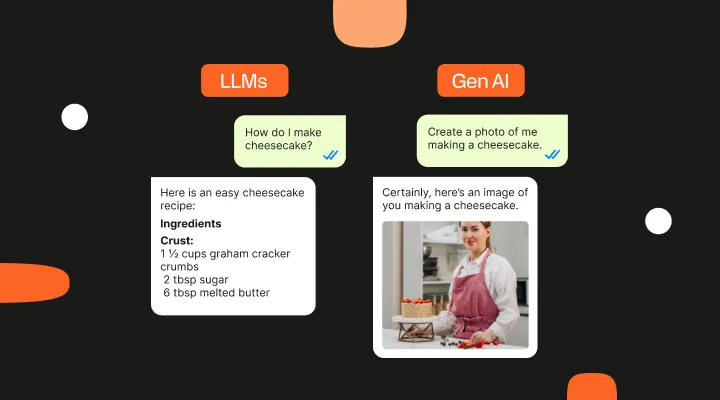What is Artificial general intelligence (AGI)?
Artificial general intelligence (AGI) is a theoretical type of artificial intelligence (AI) with capabilities that match or surpass those of humans across a wide range of cognitive tasks.
Unlike current “narrow AI” models designed for specific tasks (like playing chess or generating images), AGI would possess the ability to reason, problem-solve, learn, understand language, and even exhibit creativity in ways that are indistinguishable from human intelligence.
How is AGI different from AI?
The main difference between AGI and AI lies in their scope of capabilities and level of generalization:
- Narrow AI (or weak AI) is the type of AI we see today. It is designed to perform tasks within a limited domain. This includes image recognition, language translation, or playing chess. While it can excel at these tasks, it cannot generalize its knowledge to other areas or solve problems it hasn’t been explicitly trained on.
- Artificial general intelligence or strong AI is a hypothetical type of AI that would possess human-level intelligence across a wide range of domains. AGI would be able to reason, learn, plan, understand language, and solve problems almost identical to humans. It could apply its knowledge and skills to new situations and adapt to changing environments.
In essence, current AI systems are specialized tools designed for specific purposes. At the same time, AGI would be more akin to a general-purpose problem solver who can learn and adapt to any intellectual task that a human being can.
| Narrow AI (weak AI) | Artificial general intelligence | |
|---|---|---|
| Scope | Narrow, task-specific | Broad, human-level intelligence |
| Generalization | Limited | High |
| Learning | Supervised, specific | Unsupervised across domains |
| Problem-solving | Pre-defined rules | Flexible, creative |
| Examples | Image recognition, language translation, chess | Hypothetical, does not exist yet |
What is needed for AI to become AGI?
The transition from current AI to AGI is complex and challenging. While there’s no single agreed-upon path, several vital advancements are considered essential:
- Advanced learning algorithms: Current AI models, such as large language models (LLMs), rely heavily on supervised learning and training on massive datasets with labeled examples. Artificial general intelligence requires more sophisticated unsupervised or self-supervised learning methods, enabling it to acquire knowledge from unlabeled data and generalize across domains.
- Cognitive architectures: AGI would need a comprehensive framework for integrating different cognitive abilities, such as perception, reasoning, memory, and decision-making. This architecture should be flexible, scalable, and capable of handling the complexities of real-world situations.
- Common sense reasoning: A significant challenge for AI is understanding and applying common sense knowledge. Humans acquire it through experience and cultural immersion. Developing models that can reason about the world in a human-like way is crucial for AGI.
- Embodiment and interaction: Some researchers believe that artificial general intelligence might require a physical presence to interact with objects and environments, similar to how humans learn and develop. This could involve advancements in robotics and sensory technologies.
- Computational power: AGI models would likely require significantly more computational resources than current AI systems. Advances in hardware, such as neuromorphic computing, could help bridge this gap.
- Ethical considerations: As AI systems become more intelligent and autonomous, ethical considerations become increasingly important. Developing AGI responsibly involves addressing issues like bias, transparency, and accountability to ensure it benefits humanity.
- Interdisciplinary collaboration: Achieving AGI will likely require collaboration across diverse fields, including computer science, neuroscience, cognitive psychology, philosophy, and social sciences. Insights from different disciplines can contribute to a holistic understanding of intelligence and guide the development of AGI.
Theoretical approaches to artificial general intelligence research
To mimic complex human behavior, AGI requires capabilities like creativity, perception, learning, and memory. AI experts have proposed various approaches to drive AGI research:
- Symbolic approach: This approach hypothesizes that computer systems can develop AGI by representing human thoughts with expanding logic networks. The logic network symbolizes physical objects with if-else logic, enabling AI systems to interpret ideas at a higher level of thinking. However, symbolic representation may struggle to replicate subtle lower-level cognitive abilities like perception.
- Connectionist approach: This approach, also known as emergentism, focuses on replicating human brain structure with neural networks. Inspired by the brain’s ability to alter transmission paths based on external stimuli, scientists hope that AI models adopting this sub-symbolic approach can replicate human-like intelligence and demonstrate lower-level cognitive capabilities. Large language models are an example of AI utilizing this method to understand natural languages.
- Universalist approach: Researchers taking the universalist approach concentrate on addressing AGI complexities at the calculation level. They seek to formulate theoretical solutions that can be adapted into practical AGI systems.
- Whole organism architecture: This approach involves integrating AI models with a physical representation of the human body. Proponents of this theory believe that AGI is only achievable when the system learns from physical interactions with the environment.
- Hybrid approach: This approach combines both symbolic and sub-symbolic methods to represent human thoughts, aiming to achieve results that surpass what a single approach could accomplish. AI researchers may attempt to integrate different known principles and techniques to develop AGI.
What are some examples of artificial general intelligence?
While true artificial general intelligence remains unrealized, several existing AI systems showcase remarkable capabilities that approach or surpass human abilities in specific areas. These advancements in narrow AI are paving the way for potential AGI breakthroughs in the future.
Here are some examples of such systems:
- IBM’s Watson supercomputer leverages immense computing power combined with AI to perform complex scientific and engineering tasks, such as modeling the Big Bang theory or the human brain.
- Expert systems emulate human judgment to make recommendations or predictions in specialized fields like medicine or molecular structure.
- Self-driving cars utilize AI to perceive their surroundings, interpret traffic rules, and navigate roads safely.
- ROSS intelligence (AI attorney) can analyze vast legal documents and quickly provide accurate answers to complex legal questions.
- AlphaGo has mastered the intricate board game Go, even defeating the world champion, demonstrating exceptional problem-solving abilities within a specific domain.
- Generative pre-trained transformers (GPTs), including GPT-3 and GPT-4, can generate human-like text across various domains, often with impressive fluency and coherence. While the output is not always perfect, it highlights the potential for AI to mimic human language generation.
- Music AIs, algorithms like Dadabots can analyze existing music and generate original compositions that closely resemble the style and structure of the input data.
What are the advantages of AGI?
The potential advantages of artificial general intelligence are vast and could revolutionize numerous aspects of human life. While still hypothetical, AGI could bring the following benefits:
- Solving complex global problems: AGI’s advanced cognitive abilities could analyze vast amounts of data, identify patterns, and develop innovative solutions for complex issues like climate change, disease outbreaks, poverty, and resource scarcity.
- Scientific and technological advancements: AGI could accelerate research and development in various fields, leading to breakthroughs in medicine, energy, materials science, and space exploration. It could help design new drugs, optimize energy systems, discover new materials, and analyze complex data from scientific experiments.
- Enhanced productivity and efficiency: AGI could automate tasks across industries, improving efficiency, reducing human error, and freeing human workers to focus on more creative and strategic endeavors. This could lead to economic growth and improved quality of life.
- Personalized experiences: AGI could tailor products, services, and experiences to individual needs and preferences, from personalized medicine and education to customized entertainment and travel recommendations.
- Augmenting human capabilities: Through intelligent tools and interfaces, AGI could enhance human decision-making, creativity, and problem-solving abilities. It could provide real-time insights, suggest novel ideas, and help us understand complex information more easily.
- Exploring new frontiers: AGI could assist in exploring and colonizing space, analyzing data from distant planets, and designing life support systems for extraterrestrial environments. It could also help us understand the fundamental nature of intelligence and consciousness.
- Addressing global challenges: AGI could play a crucial role in addressing global challenges such as poverty, inequality, and environmental degradation by optimizing resource allocation, developing sustainable solutions, and fostering international cooperation.
What are the disadvantages of AGI?
While the potential benefits of artificial general intelligence are vast, it’s crucial to acknowledge the significant disadvantages and risks associated with its development:
- Bias and discrimination: If AGI systems are trained on biased data or designed with flawed algorithms, they could perpetuate and amplify existing social biases and discrimination, leading to unfair outcomes and social injustice.
- Unpredictability and unintended consequences: AGI’s complex decision-making processes could be difficult for humans to understand or anticipate, leading to unintended consequences and unforeseen risks.
Addressing these disadvantages requires careful planning, ethical frameworks, and international cooperation to ensure that AGI is developed and deployed responsibly. Prioritizing safety, transparency, and accountability to mitigate the potential risks and ensure that AGI benefits humanity is essential.
What is the future of artificial general intelligence?
The future of artificial general intelligence is a subject of intense speculation and debate, with various predictions and scenarios being proposed. Some computer scientists predict that AGI could be achieved within the next few decades, while others believe it’s still centuries away. Some experts believe that AGI is just a stepping stone towards an even more advanced form of AI: artificial superintelligence (ASI).
A 1936 foundational concept in computer science developed by Alan Turing and Alonzo Church suggests that any problem solvable by an algorithm, given enough time and memory, can be solved by a Turing machine, the theoretical model underlying modern computers.
While this supports the eventual development of AGI, the exact cognitive science algorithm that will achieve it remains a subject of debate. Some researchers believe neural networks show the most promise due to their ability to learn and adapt. In contrast, others advocate a hybrid approach combining neural networks with rule-based systems for a more structured and explainable AI.












